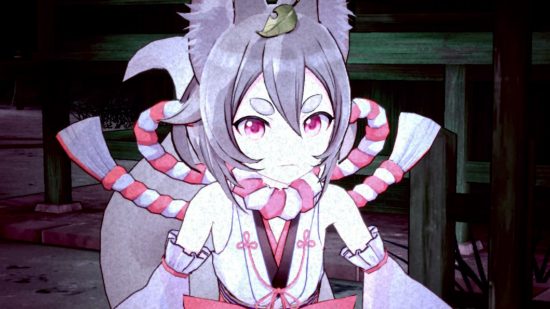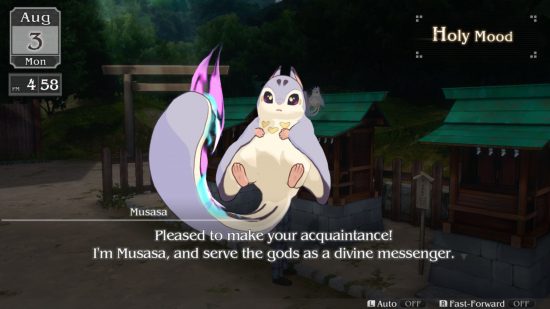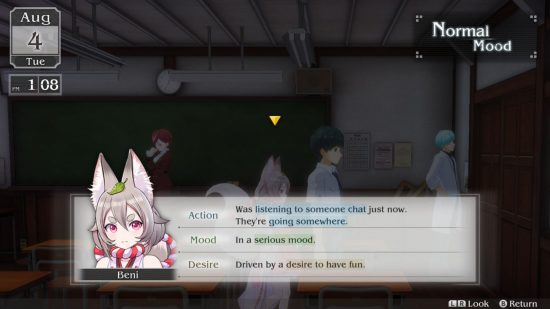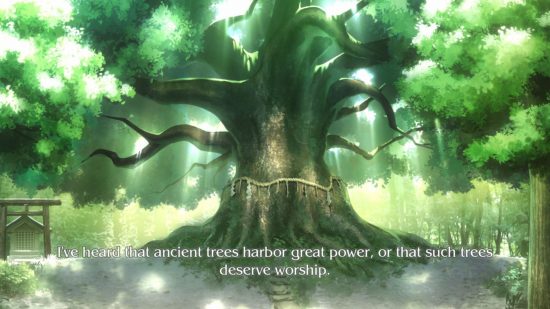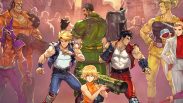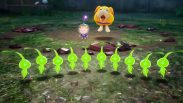Let me preface this by saying that I don’t often play visual novels or time-constricted games where decisions affect the outcome – Persona 5 is the only one that comes close to it in my repertoire. However, I like games based in Japan, especially if there’s a colorful cast of characters and an intriguing story to discover, so Loop8: Summer of Gods caught my eye.
Step into the Japanese village of Ashihara Nakatsu in the 1980s in Loop8: Summer of Gods, a supernatural story wrapped up in a charming setting accompanied by a summery soundtrack, with fully voice-acted cutscenes and well-designed characters. You play as Nini, a young man sent back to Earth from the human colony in space. Here, you’re living with a family member, Konoha, and are inducted into the slow small-town lifestyle.
After a nice and calm couple of days, you’re free to explore (and save the world) on your own. Oh, did you think it was all a peaceful life in the country? No. There’s a giant sphere floating above the town (no, not the sun) and some mysterious goings on in the rest of the country. The kegai, a type of monster from another dimension, threatens all life on Earth and are breaking through to Nini’s world. They inhabit Yomotsu Hirasaka, the Underworld, and try to keep us out with barriers. Our job is to get around these barriers and fight back.
The gameplay and what you make of Loop8 is left up to you after you’re introduced to the world. On the third ‘tutorial day’, Konoha tells you that that’s it – you’re now free to do what you want – there are no objectives, goals, or quest markers to follow. Just maybe keep an eye on the ominous “X days until the end of the world” notice that appears in the menu.
I decided it would be best to explore and improve relationships with people as much as I could, as quickly as I could. There’s a cast of twelve characters to introduce yourself to, each with a different and vibrant personality. Most are students, but a couple of them are staff at the school. The map shows who is at each location, so it’s easy to hunt people down and chat with them. With only six locations to travel to, finding everyone is pretty easy and my first step was to hit up every part of the map.
The gameplay generally feels familiar and is easy enough to get used to. If I had to liken it to anything, I’d say it’s similar to Persona 4 Golden’s day-to-day life, just a little slimmer. Time is constantly ticking and every activity you do – be it talking to people, eating a meal, or walking to a new place – takes a chunk of time and stamina. Therefore, time management is key. You can pack your day with as many activities to hone skills and improve relationships with people as you like, but keep track of your waning energy.
So where does the loop part come in? If you let time run out, then you loop back to the first day of the week, or you can choose to restart any time by talking to the character Terasu. Why would you do this? Well, if you mess up or miss something, then starting over is beneficial. Looping back does mean you have to re-introduce yourself to everyone and repeat all the same dialogue, which can get tedious after the third go.
As you speak to more characters, specifically Ichiko and Beni, you get more of an idea about the world around you and what’s going on with the evil kegai. Beni tells you about your ground-breaking Demon Sight ability and Ichiko vows to fight by your side.
Nini’s Demon Sight ability shows a person’s mood, actions, and desires. This tells you how to approach them and what effect you’ll have on your relationship by interacting at that particular time. For instance, if you approach Beni and she’s in an angry mood, teasing her may not be the best move. If someone is in a good mood, then it’s a great moment to improve your friendship.
You need to keep an eye on this in order to get people into your party, too. The only way to have others join you in battle is to speak to them and suggest that you take a walk. They can say no, but if they say yes they will accompany you even into the underworld, and fight by your side. This is quite a clunky way of forming a party, and took me a while to even work out. Having to chase down a specific character to ask them to go on a walk can eat into your precious time.
The battle system hinges on your relationship with others. The bosses you face have a character within them, and all teammates’ relationships with them can affect the types of attacks the boss uses. You can imbue Nini’s attacks with three emotions: hate, affection, and friendship. It’s not particularly clear what each one does, but hate makes the boss stronger in terms of defense and attacks, so maybe steer clear of it.
You can use Demon Sight in battle to get a preview of your teammate’s actions, though it only shows the name of it, so if you’ve not seen it before you don’t know what’s coming. These teammates are controlled by AI – no, not the ChatGPT sense, the classic computer-controlled sense that most games use. As such, you have no control over what they do in battle, so you need to react quickly if they do something that causes a problem.
I think I got progress locked or missed something in Loop8. As you fall asleep during the tutorial days, you see a barrier appear at the shrine leading to the underworld. Your instruction is to go into it and pass the trial. Then, you face a boss that is a little too strong to beat with no prior instruction. If you fail, the first instance of looping happens and you wake up on day one – I’m not sure what happens if you beat it (or if you even can).
What I think is supposed to happen next is that you spend a couple of days getting to know your fellow students and building stats ahead of the battle, and then a barrier appears with a boss behind it. You assemble your team and head into the Underworld to fight the tree monster that’s overtaken a student. You then fight it and choose to spare or end it – but beware, this can have a negative end for the student in question.
That wasn’t the case for me. What actually happened in my first run was that I killed the demon and student (oops), but then no more barriers appeared and I ran out of days, so the world ended. I restarted the loop and befriended said student, Micchi, in the first couple of days. She did not get taken into the Underworld – yay – but then no barriers appeared and time ran out thus causing the end of the world again. Beni told me to find the entrance but I checked every single nook and cranny and could not find it, nor did I get a cutscene showing it appearing like before, so I’m really not sure what I was supposed to do.

Loop8 isn’t a huge, sprawling game, but it does have a couple of hiccups. Everything tends to run fine except during battles, where movement becomes choppy and frame rate becomes an issue. I genuinely wasn’t sure if this was a stylistic choice given the grainy filter used in the underworld, but as it only happens sometimes, I think it’s a performance issue. The jolty movement can really take you out of the heat of battle and cause it to feel a bit broken.
There are a lot of loading screens and although they may not last very long, it can get distracting especially when talking to characters or heading to different rooms of the school and house. Nini’s jogging speed is also a little sluggish, with no sprint option, so catching up to characters in the big schoolyard feels like a marathon.
And now to conclude my feelings. I really enjoy the setting of Loop8, the music is nice, and the idea of the kegai descending on Earth is compelling. Getting to know all of the characters is great, though a little tiresome after the first few loops. However, the gameplay does not mesh well with my brain. That is not to say it’s bad, at all, it just isn’t quite what I expected and it maybe needs a little more direction and hints for what to do. Loop8 is essentially a very calm roguelike turned visual novel, with a couple of supernatural battles thrown in – so if that sounds like your cup of tea, then I recommend it. If you’re not a huge fan of time loops and repetition, maybe it isn’t for you.
Looking for some more Switch game recommendations? Check out our smashing Zelda: Tears of the Kingdom review and what we think of Hoyoverse’s latest game in our Honkai Star Rail review.
Loop8: Summer of Gods
While the gameplay isn’t for everyone, the world is intriguing and delightful to discover. Those who are fans of visual novels, social simulators, and battles against mysterious monsters will enjoy Loop8: Summer of Gods.
